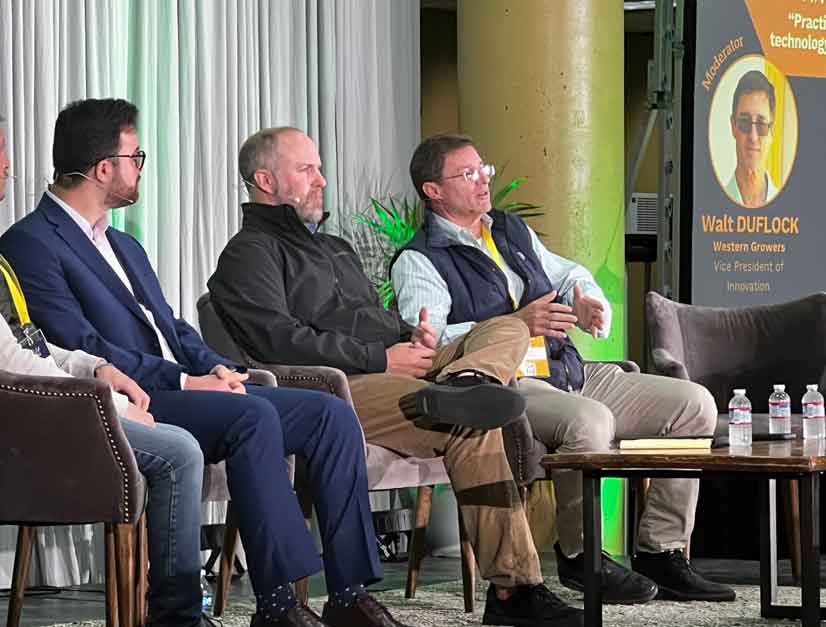The FIRA USA conference on robotics and automation has entered its second year with a focus on the berry and lettuce growers of the Central Coast. Farmers, investors and tech entrepreneurs converged this week at the Salinas Sports Complex to chat up the next tech trends on the horizon.
The three-day conference immediately dove into the unique issues with automating routine tasks for strawberry production—a commodity that soared in demand during the pandemic and has maintained market growth ever since.
According to Andrew Wulf, senior director of strawberry product leadership at Driscoll’s, strawberries continue to be the gateway to the produce aisle at the grocery store. While production costs have shot up as much as 20%, price and demand have also risen dramatically and will continue to stay strong as margins tighten, predicted Wulf.
As a result, technology is playing a larger role at Driscoll’s, helping the berry giant meet the rising consumer demand while maintaining a consistent quality.
“We're dealing with a really sensitive crop we have to ship across the entire continent, to our consumers very, very fast, and have an incredible cold chain—and be able to be very delicate with it all the way across the board,” said Wulf during a panel discussion at FIRA USA.
 Walt Duflock, Western Growers (right)
Walt Duflock, Western Growers (right)Agtech solutions that worked with lettuce, for example, may not apply to sensitive strawberries. The crops get bushy ahead of harvest, an issue in need of a pruning solution, according to Mojtaba Ahmadi, a mechanical engineer working in the Strawberry Center at California Polytechnic University, San Luis Obispo. A pruning system would make it easier for both workers and machines to find the berries and help with other issues like disease.
But he stressed that building trust among growers must be a priority. The Strawberry Center has found massive success with its field days, which connect growers to the equipment in a way they can feel they belong and can understand the technologies.
Driscoll’s has found little success with picking winners among early startups and more opportunity with companies showcased at the field day that already have a proven track record to build on, said Wulf, noting that the California Strawberry Commission has also been fostering new relationships with growers and technology.
“[Researchers] get stuck in the lab,” explained Adam Stager, founder of TRIC Robotics. “They get stuck in this bubble where they think they're solving important problems. But they don't go out and just ask around.”
Fresh out of a doctoral program with a concept to market, Stager asked the Strawberry Center if the problem he was seeking to solve was important in their view.
“They clearly said that pest control was one of the big challenges that farmers have throughout the season,” he said.
Don't miss a beat! Sign up for a FREE month of Agri-Pulse news! For the latest on what’s happening in agriculture in Washington, D.C. and around the country, click here.
He discovered that farmers were already interested in ultraviolet light for controlling weeds, which drove Stager to develop a commercially viable solution. He soon discovered that one of the best ways to win as a company is to “get lots of robots on the farm.” Augean Robotics Inc. launched an autonomous cart, called Burro, and quickly grew a following among strawberry growers, with help from the Strawberry Center as a trusted third-party advocate. That led to more opportunities to explore with the robot, according to Stager.
Eyes are now on artificial intelligence with the emergence of ChatGPT, which has gained widespread attention across industries and consumers in less than a year. Walt Duflock, vice president of innovation at the Western Growers Association, a partner in FIRA USA, has seen “a massive investment” in AI since then.
“It's a land grab game right now,” he said in describing the funding landscape. “That will trickle its way down to some of the [vertically integrated industries], like agriculture.”
While AI has been around for a long time, ChatGPT has delivered new potential for a system where farmers can better track their own on-farm data for inputs, for example, said Stager. He hoped to see AI tools that can recommend crop varieties based on specific local factors like soil type and the microclimate.
Ahmadi cautioned that such AI applications are only as good as the data fed into the system and that can be an expensive endeavor. Duflock has seen companies pull 10,000 images from a database to use for teaching a new AI technology—only to find that 500 are useful. To free engineers from that burden, Western Growers has partnered with three community colleges to build an image library for startups.
In looking at the next 50 years, Wulf sees potential for AI to securely share data across the Driscoll’s grower community at a rapid pace.
“It comes down to trust in AI,” he said. “I would say it's not there yet.”
He was hopeful that the growers who lead as early adopters can prove the concept and bring more farmers on board—but only if the engineers speak their language.
For more news, visit Agri-Pulse.com.


